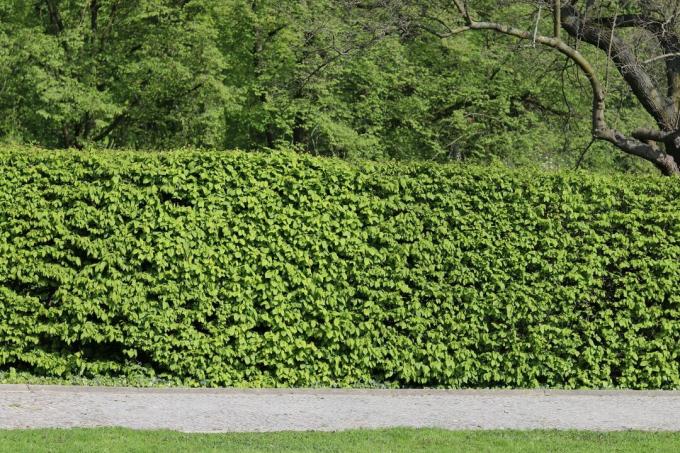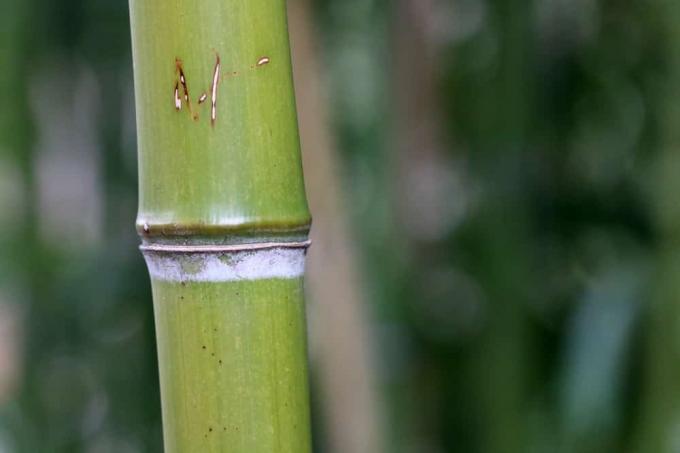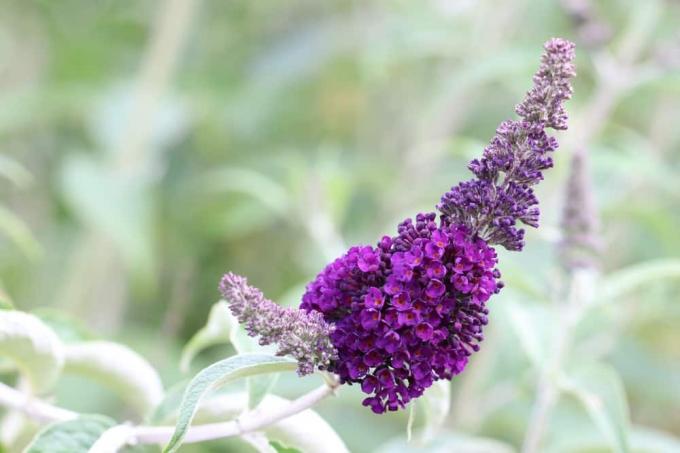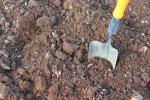

Table of contents
- The choice of plants
- Most popular hedge plants
- The right time to plant
- Step-by-step instructions
- Align and dig plant trenches
- plant spacing
- planting
- sealing and watering
- Apply bark mulch
- Hedge care tips
- Worth knowing about planting hedges shortly
- Planting tips
Hedges take on all sorts of tasks in the home garden. Large specimens offer small mammals and birds a perfect habitat, protect against wind and prying eyes and serve as a natural boundary. Smaller hedges visually enhance the green living room as a design element. They can be used to divide beds, delimit areas in the garden or surround a seat. Trimmed hedges are suitable for planting. These are not only inexpensive, but also durable.
The choice of plants
There is a large selection of hedge plants in specialist shops. It is not always easy to find suitable plants right away. The choice of plants depends on the site conditions. Are the plants in full sun, in the shade, or both? The question of the soil conditions is also crucial. Among the shrubs there are varieties that already have high requirements and others that thrive on almost any soil. Another point is the workload. Fast growing hedges need to be trimmed once or twice a year. If you want to do without it, choose slow-growing hedges. And finally, the look plays a decisive role in the selection of hedge plants.
Most popular hedge plants
Should it be an evergreen hedge that sets accents in the garden even in winter? Or would you prefer a variant that sheds leaves or that enchants with its colorful flowers? The most popular hedge plants include varieties such as privet, yew, cypress, thuja, cherry laurel or the hornbeam hedge. Each hedge plant has its own advantages and disadvantages.
The right time to plant
Hedge plants should generally be planted in late fall. They take root before the first frost and the risk of leaf damage is significantly reduced. Another advantage is that the plants do not sprout late in the spring. In addition, the hedge can also be planted in the spring – before it buds. However, additional watering is often required. However, before planting can begin, the prescribed boundary distance to the neighbor's property must be checked. In order to avoid unnecessary trouble with the neighbours, it is advisable to inquire about the regulations with the respective municipality beforehand.
Step-by-step instructions
Careful preparation is necessary to make the hedge an eye-catcher. This includes the initial care of the hedge plants. Bare root hedge plants should be soaked in water up to 24 hours before planting. In the case of container or ball plants, the pot is dipped in water before planting until no more bubbles appear. If the hedge cannot be planted immediately, it is advisable to place the plants in a large hole in the ground, cover them with soil and flood them with water.
Align and dig plant trenches
Align the planting trench using a guide line. If you don't have a guideline at hand, you can use a clothesline wound around two pegs and stretch it across the ground as a line. Dig a planting trench about 30 cm deep and 50 cm wide and fill it with mature compost. Alternatively, the soil can be loosened with a power tiller and mature compost worked in. The compost improves the water and air balance in the root area. In addition, root formation is promoted.
plant spacing
The planting distances are now determined using a bamboo pole (one meter). To do this, simply draw lines on the bamboo pole, depending on the type and variety. For hedges that remain small (about one meter), three to four plants per meter are required. The planting distance for high hedges is two to three plants per meter.
planting
The plants are placed in the planting trench along the guide line and at a suitable distance. When planting, make sure that the root ball of the hedge is level with the ground.
sealing and watering
The enriched and excavated soil is then filled back into the planting trench in the next step. Shake the plant a little so that there are no cavities between the roots. Tamp down the earth with feeling and form the pouring rim. Then the roots have to be literally sludged.
Apply bark mulch
When the water has completely drained away, the earth is loosened up again. Finally, the root balls are covered with a thick layer of bark mulch. As a result, the soil does not dry out and the young hedge plants are protected from frost damage. Bark mulch is also very helpful against weeds.
Hedge care tips
Whether deciduous hedge species such as privet or beech or evergreen species such as firethorn, conifer or cherry laurel - they all have one thing in common. Decorative hedge plants need to be cared for and trimmed regularly. A cut is not only used to ensure that the hedge remains opaque, grows faster or becomes more and more branched. The hedge is also given a shape by the hedge trimming that can set beautiful accents in the garden - provided you can. If you want to cut back the hedge, you should do this in the spring. Mid-March is a good time here, because it is before the plant sprout. A later pruning should not be done, because hedges offer many bird species a breeding ground. The second pruning then takes place in the months from August to October.
The only thing to note is that the cut is trapezoidal. That is, wide at the base and narrower towards the top. In this way, the hedge remains dense in the lower area and gets the sunlight it needs to grow. The topiary can be carried out from March to the end of September. Please do not cut later, otherwise the first night frosts can damage tender shoots. All in all, planting hedges with the steps mentioned above is just as easy as maintaining them. It is only important that the prescribed limit distance and the cutting date are observed. With the right tools, nothing can stand in the way of maintaining the hedge.
Worth knowing about planting hedges shortly
In the case of newly planted hedges on fertile farmland, thinning out the soil can make sense in order to avoid fast-growing to suppress nutrient-loving species and to allow for a much more species-rich population of rare specialists support financially. The clippings from the annual mowing and the pruning of trees and shrubs must be removed over a period of several years. Otherwise, the clippings should remain in place to promote the formation of litter, mold and raw humus horizons and dead wood.
Since the beginning of the 1990s, so-called Benje hedges in particular have been propagated as new hedges. The principle of the Benje hedges is not to build up hedges by planting new ones, but by bringing in seeds from birds. For this purpose, prunings are laid down in strips and after a herb stage that is usually rich in stinging nettles, bush encroachment sets in. The advantage is that this form of installation is inexpensive and native seeds are planted by birds. The disadvantage is that shrubs made from cuttings of wood that can sprout, such as blackberries, are particularly popular. While this can have a positive impact on bird life, small mammals and insects, the Benje hedge is rather meaningless for botanical species protection. It has proven to make more sense to supplement Benje hedges with woody plantations.
Planting tips
- When planting hedges, it is usually advisable to dig a planting trench twice the width and depth of the plant root ball
- For heavy soils, mix the excavation with sand or lava granules and work in some organic fertilizer (e.g. B. compost or horn shavings)
- Shorten plants from deciduous hedges by 1/3 to 1/2 - only cut coniferous trees to a uniform height
- Distribute the shrubs evenly in the planting trench so that the side shoots are just touching
- When filling the planting ditch, shake the plants and step on the soil mixture to avoid cavities
- Create a watering wall and water the plants well
- planting area with bark mulch cover to prevent the soil from drying out quickly.
Hedge plants that are suitable for the garden include:
- Privet and cherry laurel
- Yew, tree of life and cypress
- beech and hornbeam
 garden editorial
garden editorial I write about everything that interests me in my garden.
Learn more about hedges

Hornbeam hedge: 17 tips for care
Hornbeams (Carpinus betulus) are most commonly used as topiaries or hedge plants. They are actually not beeches at all, but belong to the birch family. The hornbeam is very robust, easy to care for and, in contrast to the common beech, not poisonous.

How fast does bamboo grow? | Information about growth
In domestic gardens, bamboo is usually used as a privacy screen or as a decorative solitary plant. The rapid growth, which can reach several cm a day, is impressive. It depends on the bamboo variety, care and the prevailing microclimate.

How fast does cherry laurel grow? | accelerate growth
The cherry laurel is a fast and densely growing tree. After planting, it usually only takes a few years for the young plants to grow into a tall, dense and evergreen hedge. In addition, growth can be accelerated by additional precautions.

Creating a mixed colorful hedge: 9 ideas for a mixed hedge
If you don't like it monotonous, you can also create a mixed hedge instead of a hedge from a single, evergreen plant species. There is a wide range of colorful hedges to choose from. There are special flowering hedges, ones for birds, scented ones, or for insects and butterflies.

Yellow cypress | 9 tips for care, pruning & growth
The yellow cypress is one of the most common hedge plants in our gardens. No wonder: it combines a great look with an opaque growth. How to properly care for them, cut them and generally promote their growth is here.

Thuja brabant turns brown or yellow: what to do? 8 common causes
When Thuja brabant turns yellow or brown, various factors can be responsible - but care mistakes are often the trigger. We reveal which factors are involved and how they can be counteracted.



